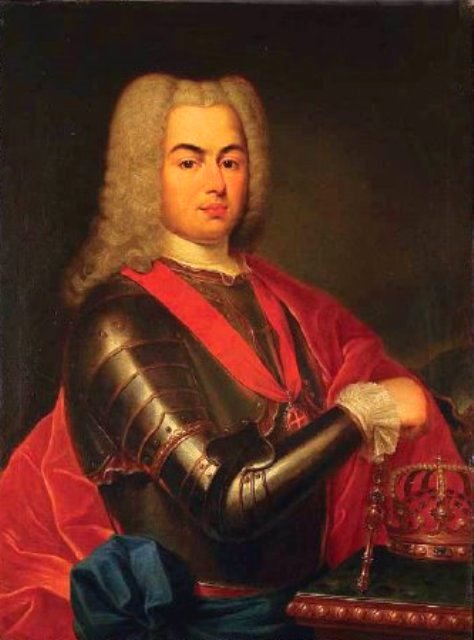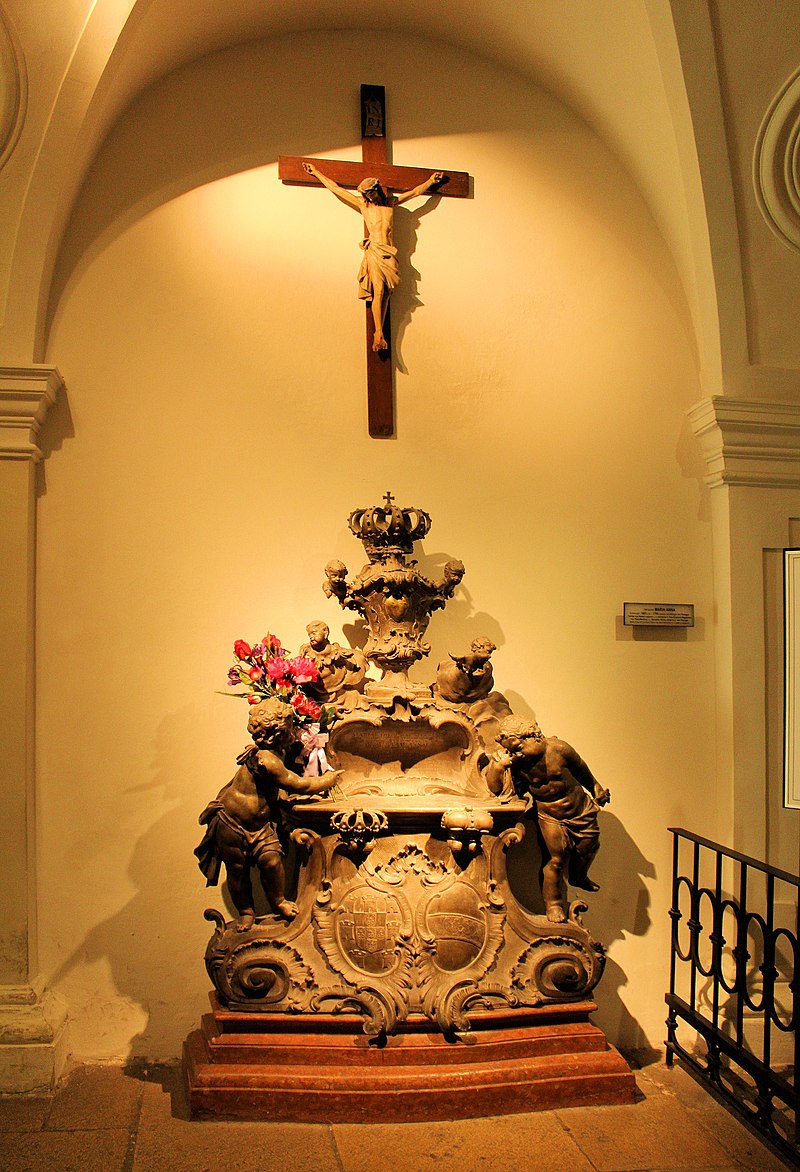by Susan Flantzer
© Unofficial Royalty 2022

Maria Anna of Austria, Queen of Portugal; Credit – Wikipedia
Archduchess Maria Anna Josepha Antonia Regina of Austria was the wife and first cousin of João V, King of Portugal. The fifth of the ten children and the third of the seven daughters of Leopold I, Holy Roman Emperor and his third wife Eleonore Magdalene of Neuburg, Maria Anna was born on September 7, 1683, in Linz, Austria. At the time of her birth, an attempt by the Ottoman Empire to capture Vienna was occurring and so Maria Anna’s family was in temporary exile in Linz. A month later, the siege of Vienna was successfully repelled and the Ottoman Turks were driven out of Austria. Maria Anna’s paternal grandparents were Ferdinand III, Holy Roman Emperor and his first wife Maria Anna of Spain. Her maternal grandparents were Philipp Wilhelm, Elector Palatine, Count Palatine of Neuburg and Duke of Jülich-Berg and his second wife Elisabeth Amalie of Hesse-Darmstadt.
Because Maria Anna’s father Leopold I, Holy Roman Emperor had only one surviving child from his first two marriages, a daughter, (see below), he needed to marry again to provide male heirs. He chose Eleanore Magdalene of Neuberg to be his third wife due to the fertility of her family. Eleanore Magdalene’s mother had 23 pregnancies and 17 live births and the family gained the reputation as a fertile family. Leopold made a good choice because his third wife had ten children including two Holy Roman Emperors.

Leopold I, Holy Roman Emperor with his family; Credit – Wikipedia
Maria Anna had nine siblings:
- Joseph I, Holy Roman Emperor (1678 – 1711), married Wilhelmine Amalia of Brunswick-Lüneburg, had three children, their only son died of hydrocephalus before his first birthday
- Maria Christina of Austria (born and 1679), died at birth
- Maria Elisabeth of Austria, Governor of the Austrian Netherlands (1680 – 1741), unmarried
- Leopold Joseph of Austria (1682 – 1684), died in early childhood
- Maria Theresia of Austria (1684 – 1696), died from smallpox at the age of 12
- Karl VI, Holy Roman Emperor (1685 – 1740), married Elisabeth Christine of Brunswick-Wolfenbüttel, had one son who died in infancy and three daughters, father of Maria Theresa, Archduchess of Austria, and Queen of Hungary, Croatia, and Bohemia, the only woman to rule the Habsburg dominions in her own right
- Maria Josepha of Austria (1687 – 1703), died from smallpox at the age of 16
- Maria Magdalena of Austria (1689 – 1743), unmarried
- Maria Margaretha of Austria (1690 – 1691), died in infancy
Maria Anna had four half-siblings from her father’s first marriage to Margarita Teresa of Spain (1651 – 1673). Only one survived infancy. Margarita Teresa was weakened due to six pregnancies in six years (four live births and two miscarriages) and died four months into her seventh pregnancy at the age of 21.
- Ferdinand of Austria (1667 – 1668), died in infancy
- Maria Antonia of Austria (1669 – 1692), married Maximilian II Emanuel, Elector of Bavaria, had one surviving son who died at the age of six
- Johann Leopold of Austria (born and died 1670), died on the day of his birth
- Maria Anna of Austria (born and died 1672), died in infancy
Maria Anna had two siblings from her father’s second marriage to Claudia Felicitas of Austria (1653 – 1676), who died from tuberculosis at the age of 22. Neither of their two daughters survived:
- Anna Maria of Austria (born and died 1674)
- Maria Josepha Clementina (1675 – 1676), died in infancy
Maria Anna was well-educated and musically gifted. She had an extensive education in foreign languages. Besides her native German, she was fluent in French, Italian, Spanish, and Latin and understood English. After her marriage to Joao V, King of Portugal, Portuguese was added to the list.

João V, King of Portugal in 1707, aged 18; Credit – Wikipedia
In Portugal, Pedro II, King of Portugal had laid the groundwork for the marriage of his son, the future João V, King of Portugal, with an Austrian archduchess to guarantee Portugal’s alliance with the Habsburgs. After his father died in 1706, João V, now King of Portugal, continued these negotiations, and finally, a marriage contract was signed on June 27, 1707. Maria Anna was to be João’s bride. João’s mother Maria Sophia of Neuburg and Maria Anna’s mother were sisters and so Maria Anna and João were first cousins.

The landing of Maria Anna in Lisbon; Credit – Wikipedia
On July 9, 1708, a proxy marriage took place at St. Stephen’s Cathedral in Vienna, Austria with the groom represented by Maria Anna’s brother Joseph I, Holy Roman Emperor. Maria Anna sailed from the Netherlands to Lisbon, Portugal in a fleet of eighteen ships. 19-year-old João V and 25-year-old Maria Anna were married on October 26, 1708, at Ribeira Palace in Lisbon, Portugal. The expensive and sumptuous marriage celebrations lasted for two months.

Maria Anna and João V’s two eldest children Pedro and Barbara; Credit – Wikipedia
João V and Maria Anna of Austria had six children:
- Infanta Barbara of Portugal (1711 – 1758), married Fernando VI, King of Spain, no children
- Infante Pedro of Portugal (1712 – 1714), died in early childhood
- José I, King of Portugal (1714 – 1777), married Mariana Victoria of Spain, had four daughters including his successor Maria I, Queen of Portugal who married her paternal uncle Pedro (below)
- Infante Carlos of Portugal (1716 – 1736), died of a high fever, aged 19
- Pedro III, King of Portugal (1717 – 1786), married his niece Maria I, Queen of Portugal, and was her co-ruler, had six children
- Infante Alexandre of Portugal (1723 – 1728), died in childhood from smallpox
Soon after her marriage, Maria Anna realized that beauty and luxury were valued at the Portuguese court much more than learning and knowledge, which were the traits valued at the Austrian court. João had many mistresses and several illegitimate children. Although he was well-educated and religious, he occupied himself with whatever pleased him at the moment. Maria Anna occupied herself with religious practices: founding convents and churches, helping the poor, and feeding orphans. Passionate about music, Maria Anna attended concerts and operas at court and often participated in them by singing arias.

Maria Anna, circa 1729; Credit – Wikipedia
Maria Anna served as Regent of Portugal twice. In 1716, João V temporarily left Lisbon for the Ducal Palace of Vila Viçosa, on the opposite side of Portugal, along the border with Spain, to recuperate from depression, and Maria was regent while he was in Vila Viçosa. Previously, he had depressive conditions upon the death of his mother in 1699 and the death of his sister Teresa Maria in 1704. On May 10, 1742, 52-year-old João had a stroke and became partially paralyzed. He recovered somewhat but was left diminished and much less energetic. Maria Anna served as regent for the rest of his life. After a reign of forty-three years, João V, King of Portugal, aged 60, died on July 31, 1750, at Ribeira Palace in Lisbon, Portugal, and was succeeded by his eldest surviving son José I, King of Portugal.

The internment site of Maria Anna’s heart in the Imperial Crypt at the Capuchin Church in Vienna, Austria; Credit – Por Dguendel – Obra do próprio, CC BY 4.0, https://commons.wikimedia.org/w/index.php?curid=92274655
Maria Anna of Austria, Queen of Portugal died, aged 70, on August 14, 1754, at the Palace of Belém in Lisbon, Portugal. She was initially interred at the Monastery of São João Nepomuceno (Saint John Nepomuk), which she founded. According to her wishes, her heart was interred in the Imperial Crypt at the Capuchin Church in Vienna, Austria, the burial place of her birth family, the Habsburgs.

Royal Pantheon of the House of Braganza at the Monastery of São Vicente de Fora; Credit – Wikipedia
In 1855, during the reign of Pedro V, King of Portugal, Maria Anna’s remains were transferred from the Monastery of São João Nepomuceno to the Royal Pantheon of the House of Braganza at the Monastery of São Vicente de Fora in Lisbon, Portugal, where her husband João V had been interred.
This article is the intellectual property of Unofficial Royalty and is NOT TO BE COPIED, EDITED, OR POSTED IN ANY FORM ON ANOTHER WEBSITE under any circumstances. It is permissible to use a link that directs to Unofficial Royalty.
Works Cited
- De.wikipedia.org. 2022. Maria Anna von Österreich (1683–1754) – Wikipedia. [online] Available at: <https://de.wikipedia.org/wiki/Maria_Anna_von_%C3%96sterreich_(1683%E2%80%931754)> [Accessed 3 June 2022].
- En.wikipedia.org. 2022. Leopold I, Holy Roman Emperor – Wikipedia. [online] Available at: <https://en.wikipedia.org/wiki/Leopold_I,_Holy_Roman_Emperor> [Accessed 3 June 2022].
- En.wikipedia.org. 2022. Maria Anna of Austria – Wikipedia. [online] Available at: <https://en.wikipedia.org/wiki/Maria_Anna_of_Austria> [Accessed 3 June 2022].
- Flantzer, Susan, 2022. João V, King of Portugal. [online] Unofficial Royalty. Available at: <https://www.unofficialroyalty.com/joao-v-king-of-portugal/> [Accessed 3 June 2022].
- Louda, Jiri and Maclagan, Michael, 2002. Lines of Succession. London: Little, Brown.
- Pt.wikipedia.org. 2022. Maria Ana de Áustria, Rainha de Portugal – Wikipédia, a enciclopédia livre. [online] Available at: <https://pt.wikipedia.org/wiki/Maria_Ana_de_%C3%81ustria,_Rainha_de_Portugal> [Accessed 3 June 2022].
